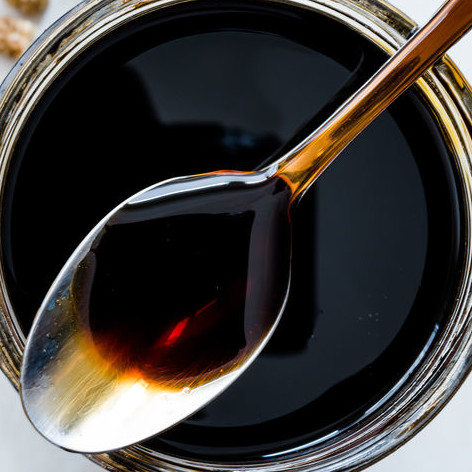
Molasses
Also known as blackstrap or cane molasses
What is Molasses?
Molasses is a general term used for the concentrated juice obtained from sugarcane and sugar beet after the removal of sucrose. The result is a heavy, dark-colored and viscous liquid. Some common uses in baked goods include cookies, biscuits and breads.1
Typically, molasses used for food applications is made up of blends of various concentrates to produce an ingredient with consistent:1
- Color
- Flavor
- Functional properties
| Type | Color | Flavor |
| Light | Golden | Mild |
| Medium or Dark | Light to medium dark | Mild to strong |
| Blackstrap | Very dark | Bitter-sweet |
| Treacle | Pale | Mellow sweet |
| Sorghum | Amber | Mild |
Origin
The oldest written mention of molasses is found in a portuguese book published in the 1500s. The term comes from the portuguese word “melaço.” Its introduction to the United States was via the Caribbean English colonies where it was used in the production of rum.
Molasses was the primary sweetener in the United State up until World War I, when it was replaced by sucrose. Today, it’s considered a health food product due to high minerals and vitamins content.2
Function
Molasses serve several purposes in baked goods such as:3,4
- Sweetening: contributing to sweetness, although with lower intensity than sucrose. Its sweetness decreases as color darkens
- Flavor: providing a broad and complex range of flavors, from caramel to bitter notes
- Color: providing a dark brown color and disguises grey or grey-brown tones
- Humectancy: retaining moisture due to its water absorption capacity
- Moistness and softness: aid in the retention of moistness and softness
- Subtract for Maillard: providing part of subtract necessary for the browning Maillard reaction
- Buffering: its salt content (2-9%) provides a buffering effect that contributes to pH stabilization in fermented products
- Leavening: natural acids found in it can aid with leavening along with baking soda
- Preventing/retarding staling: due to its water absorption capacity
Nutrition
Composition per (100 grams):5
| Component | Grams |
| Water | 21.87 |
| Carbohydrates | 74.73 |
| Fat | 0.1 |
| Ash | 3.3 |
Molasses are rich in essential minerals such as calcium, potassium, magnesium, among others. The presence of B-vitamins and health promoting polyphenolic compounds contributes to molasses positive health effects mainly combating heart disease, obesity and neurodegenerative diseases.2,3
Commercial production
Molasses are commercially obtained through the following process:1
- Receiving and storing: sugar cane or sugar beet is received and stored in a humidity controlled environment.
- Milling: the beet or sugar cane is sliced into small pieces with water to aid the milling process. Up to 96% of the sugar is extracted in this step.
- Clarification: the juice is superheated to coagulate impurities followed by clarification via settling.
- Evaporation: the clarified juice is concentrated through several multiple-effect evaporators.
- Centrifugation: crystallized sugar is separated from the molasses thorough a centrifugation process
Application3,6
Molasses is used in several baked goods such as gingerbread cookies, ginger snaps, breads, cakes and biscuits. It can also be used in the manufacture of dark sugar which, depending on the molasses color, can produce sugar from yellow to golden colored.
When baking with this ingredinet some considerations should be taken into account:
- Substitution of sucrose: 1 cup of sucrose can be substituted with 1 ⅓ cup of molasses. The liquids must be reduced to account for the molasses water content.
- Substitution of brown sugar: to substitute 100 grams of brown sugar mix 90 grams of sucrose with 10 grams of molasses.
- Acidity: molasses is more acidic than sucrose. Therefore, the addition of ½ teaspoons of baking soda per cup of molasses is essential.
- Color: molasses imparts a dark brown color to baked goods. No more than half of sucrose should be replaced with it. For gingerbread cookies, dark varieties are used along with lower levels of baking soda to avoid over darkening.
- Flavor: it can impart a strong characteristic flavor to baked goods and confections.
- Softening: the high water absorption capacity may cause quicker softening of cookies.
FDA regulations
Molasses are generally recognized as safe (GRAS) by the FDA for its intended use.5
References
- Marie, S, and J. R Piggott. Handbook Of Sweeteners. 1st ed., Springer Science & Business Media, 1991, pp. 56-59.
- Goldstein, Darra, and Sidney Mintz. The Oxford companion to sugar and sweets. 1st ed.,Oxford University Press, 2015, pp. .
- Figoni, P. How Baking Works: Exploring The Fundamentals Of Baking Science. 3rd ed., John Wiley & Sons, Inc., 2010, pp. 177-180.
- Varzakas, Theodoros, Athanasios Labropoulos, and Stylianos Anestis. Sweeteners: nutritional aspects, applications, and production technology. 1st ed., CRC Press, 2012, pp. 226-230.
- U.S. Department of Agriculture, Agricultural Research Service. FoodData Central, 1 April 2020. https://fdc.nal.usda.gov/fdc-app.html#/food-details/789128/nutrients. Accessed 3 June 2020.
- Marcus, J B. Culinary Nutrition:The Science And Practice Of Healthy Cooking. 1st ed., Elsevier/Academic Press, 2013, pp. 164.

